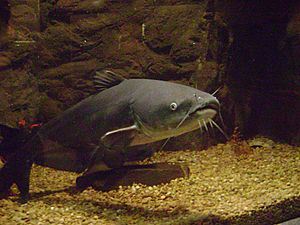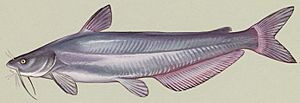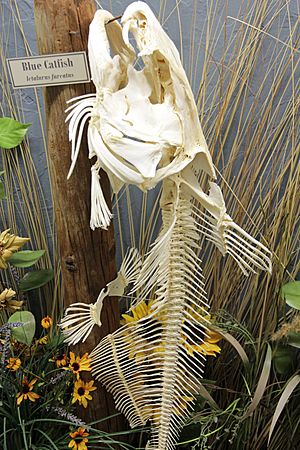Blue catfish facts for kids
Quick facts for kids Blue catfish |
|
|---|---|
 |
|
| Conservation status | |
| Scientific classification | |
 |
|
| Native distribution of Ictalurus furcatus | |
| Synonyms | |
|
The blue catfish (Ictalurus furcatus) is the biggest type of North American catfish. These fish can grow very large! They can reach up to 165 cm (65 in) long and weigh as much as 68 kg (150 lb).
Most blue catfish are about 25 to 46 inches (64–117 cm) long. They can also live for a long time, sometimes up to 20 years.
Blue catfish naturally live in the Mississippi River system. This includes big rivers like the Missouri, Ohio, Tennessee, and Arkansas River. You can also find them in the Rio Grande and along the Gulf Coast, all the way to Belize and Guatemala.
People have also moved these large catfish to other places. They now live in lakes and rivers like the Santee Cooper lakes in South Carolina and the James River in Virginia. You can even find them in some lakes in Florida.
In some areas, like the Chesapeake Bay, blue catfish are considered an invasive species. This means they are not native to the area and can cause problems for the local environment. Blue catfish can live in slightly salty water, which helps them spread along coastal waterways.
Contents
Amazing Record-Setting Fish
Blue catfish can grow to incredible sizes, and some have set new records!
Virginia's Biggest Catch
On June 18, 2011, a fisherman named Nick Anderson caught a huge blue catfish. He was fishing in John Kerr Reservoir, also known as Buggs Island Lake. This lake is on the border between Virginia and North Carolina.
Nick's fish weighed an amazing 143 pounds! It was 57 inches (145 cm) long and 47 inches (120 cm) around. Just a few days later, Virginia officials confirmed it was the biggest blue catfish ever caught in the state.
South Carolina's Giant Catfish
Another massive blue catfish was caught on February 7, 2012. This one weighed 136 pounds and was 56 inches long. It was caught in Lake Moultrie, one of the Santee Cooper lakes in South Carolina.
This fish was the heaviest blue catfish ever weighed on a certified scale in South Carolina. However, it couldn't be a state record because it wasn't caught with a fishing rod and reel.
World Record Fish
On July 20, 2010, Greg Bernal caught what might be a new world record blue catfish. He caught it in the Missouri River in Florissant, Missouri. His girlfriend, Janet Momphard, helped him land the giant fish.
This record catfish weighed 130 pounds! It was 57 inches long and 45 inches around. The previous world record was 124 pounds, caught by Tim Pruitt in the Mississippi River in 2005.
Hand-lining Record
Zachary Gustafson is an expert at hand-lining, which means catching fish without a rod. On June 5, 2015, he caught a 107-pound blue catfish in the Potomac River. He used a sausage and a circle hook to catch this record-setting fish.
Indiana's Record
The record for a blue catfish in Indiana was set in 1999 by Bruce Midkiff. He caught a 104-pound fish in the Ohio River.
How to Identify a Blue Catfish
Sometimes, people confuse blue catfish with channel catfish. But there are ways to tell them apart!
Blue catfish usually have a bluish-gray color and a strong, heavy body. They also have a small hump on their back. The best way to know for sure is to count the number of rays on their anal fin (the fin on their belly, near the tail).
A blue catfish has 30 to 36 rays on its anal fin. A channel catfish, however, only has 25 to 29 rays. Blue catfish also have whiskers called barbels, a deeply forked tail, and their upper jaw sticks out a bit.
What Blue Catfish Eat
Blue catfish are "opportunistic predators." This means they will eat almost any fish they can catch. They also enjoy eating crawfish, freshwater mussels, frogs, and other food they find in the water.
It's even easier for them to catch food if it's already hurt or dead. Blue catfish are known to feed below schools of striped bass in open water. They also eat wounded baitfish that have been washed through dam spillways.
Interestingly, blue catfish are one of the few fish in the Mississippi River basin that can eat adult Asian carp.
Blue Catfish as an Invasive Species
Blue catfish can live in many different climates and even in slightly salty water. This has allowed them to spread quickly in Virginia's rivers, lakes, and the Chesapeake Bay.
Unfortunately, they are considered a problematic invasive species in Virginia. This is because they have a low death rate, grow very large, and eat many different kinds of prey. Since they were brought to Virginia in the 1970s, their numbers have grown a lot.
Studies have shown that there are many more blue catfish in Virginia's rivers now than in their native homes. This means they are a very common fish in the freshwater and slightly salty parts of Virginia's tidal rivers.
At first, people worried that blue catfish would harm native fish like American shad and alewife. However, research has shown that blue catfish don't eat many of these fish.
Scientists from Virginia Tech found that blue catfish mostly eat plants like hydrilla and Asian clams. Both of these are also invasive species in the Chesapeake Bay. Blue catfish do eat blue crabs sometimes. This can be a problem because blue crabs are very important for fishing in the Chesapeake Bay.
See also
 In Spanish: Bagre azul para niños
In Spanish: Bagre azul para niños




